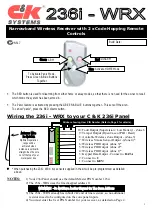
10
Aerial connections
Pre Out
Sub Out
FM aerial
FM external
aerial
(recommended)
AM external aerial
(recommended)
AM loop
aerial
OR
OR
Ground
(optional)
Examples
Using the tuner
Change the tuning mode to Preset, Manual or Scan via 'Input Setup > Mode'
when the FM or AM tuner is selected.
Press the /- button on the front panel (or the
▲
and
▼
buttons on
the remote) to select station.
Frequency increments can be set for AM/FM depending on geographic
location. 'General Settings > AM/FM Tuner Steps'.
Radio Data Systems (RDS)
Press the Info button on the remote to choose:
PS (Station Name) – Current station name will be shown.
PTY (Program Type) – Current program type will be shown.
RT (Radiotext) – Radiotext messages will be shown, if available.
Note: If no valid RDS data has been received the Info button will display the
normal unit information.
Presets
1. Press and hold the Store Presets button on the remote for 5 seconds.
2. Use the /- on the front panel or the navigation buttons to select a
preset station number (1-30).
3. Press the Store Presets button on the remote to store the station.
StreamMagic
On the Connect App you can search for an Internet Radio station and then
add it to a Preset memory location in the app.
Operating instructions
To activate the CXR, switch the Power switch on the rear panel to On then
press the Standby/On button on the front panel.
Selecting the source
Select the source by using the /- buttons on the front panel. After
4 to 5 seconds the CXR will select the new source, or it can be selected
by pressing the volume knob. The source selection buttons on the remote
control can also be used to directly select the source.
Selecting the desired listening mode
Select an appropriate mode for the source material/type you are listening to
by pressing the Stereo or Surround Modes button on the remote.
Surround sound modes
The CXR supports several music and home-cinema listening modes. The
output the CXR can provide depends both on the source signal present, the
speaker setup selected and the decode mode selected.
Dolby's lossless audio technology developed primarily for high capacity
Blu-ray discs/players. Dolby True HD delivers theoretically bit-for-bit sound
identical to the studio master by the use of 100% lossless encoding. Previous
formats such as Dolby Digital 5.1 or EX have used lossy encoding where
some data (that is theoretically less audible) is always lost in the encoding
process to reduce the storage capacity needed on the disc. This is a new
format that supports up to eight (usually used as 7.1) full-range channels of
24-bit/96 kHz audio or two channels of 24/192 kHz via Blu-ray discs and is
not backwards compatible with earlier schemes. The format can either be
transmitted as a 'bitstream' to the CXR for internal decoding (recommended)
or can be decoded by some Blu-ray players internally and sent to the CXR
as multi-channel PCM. In both cases an HDMI connection is required to the
CXR and a suitable Blu-ray player as Dolby True HD is only ever transmitted
over HDMI.
An encoding scheme based on the original Dolby Digital CODEC, but with
enhancements to improve coding efficiency and improved audio quality.
Dolby Digital Plus supports 7.1 fully discrete channels compared to Dolby
Digitals 5.1 (or 6.1 in its EX variant where the 6th channel is matrix encoded).
These Dolby Digital Plus bitstreams are not backward compatible with legacy
Dolby Digital decoders but require an AV Receiver developed to decode them
(such as the CXR) and an HDMI connection as Dolby Digital Plus is currently
only transmitted over HDMI. It is however a requirement that any Dolby Digital
Plus enabled Blu-ray player must also be able transform the Dolby Digital
Plus into a backwards compatible Dolby Digital 5.1 output for playback on
legacy Dolby Digital systems. The CXR is however fully compatible with Dolby
Digital Plus.
A new lossless audio codec from DTS, rather than being incompatible with
earlier versions, DTS-HD Master Audio is transmitted as an extension to a
normal DTS bitstream. A second embedded stream is sent which contains
the "difference" between the original studio master and the lossy compressed
DTS, plus the two extra channels. DTS-HD Master Audio enabled devices
(such as the CXR) are able to use this difference information to recreate a bit
for bit lossless version of the original 7.1 data. Devices which do not support
the Master Audio extension simply decode the original 5.1 DTS stream and
ignore the Master Audio extension providing backwards compatibility.
DTS-HD High Resolution Audio
Known also as DTS-HR an extension to the original DTS audio format. DTS-
HD High Resolution Audio supports 7.1 fully discrete channels compared to
DTS's 5.1 (or 6.1 in its DTS ES Matrix or DTS ES Discrete variants). As with
DTS-HD Master Audio a second embedded stream is sent which contains the
"difference" between the original studio master and the lossy compressed
DTS, plus the two extra channels, however in this case the extra stream is
also formed by lossy compression. Effectively this is a 7.1 version of DTS
which can be decoded by devices (such as the CXR) which are able to
decode DTS-HD High Resolution Audio. Devices which do not support the
High Resolution extension simply decode the original 5.1 DTS stream and
ignore the High Resolution extension providing backwards compatibility.
Known also as Dolby Digital (3/2) or Dolby Digital 5.1, provides (up to) 5.1
output from suitable encoded Dolby Digital material, with 5 main channels
(Front Left, Front Right, Centre, Surround Left, Surround Right) and a
Low Frequency Effects Channel for the subwoofer, all discretely encoded.
Decoding Dolby Digital requires a Dolby Digital encoded DVD disc and a
digital connection from the source equipment (Such as a DVD player) to the
CXR.
Summary of Contents for Topaz SR20
Page 1: ...CXR120 200 AV RECEIVER...



































